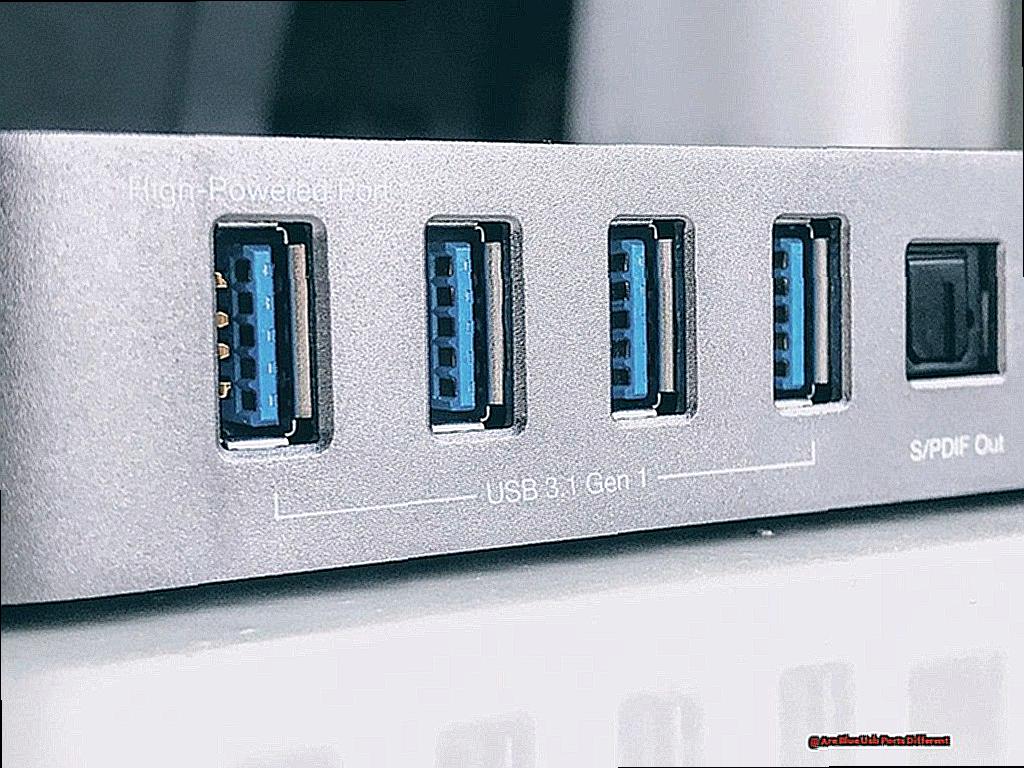
Welcome to our tech-savvy corner of the internet, my fellow USB enthusiasts.
Today, we’re delving into the world of USB ports and shining a spotlight on one particular hue: blue. You’ve probably noticed that not all USB ports are created equal – some are black, some are white, and then there’s the mysterious blue port.
But what makes this blue port stand out from the rest? Is it just a superficial change or does it actually have a significant impact on performance?
So sit back, relax, and prepare to become a USB expert with us.
Are Blue Usb Ports Different?
Contents
- 1 Are Blue Usb Ports Different?
- 2 Introducing Blue USB Ports: What Makes Them Different?
- 3 Speed Comparison: USB 2.0 vs USB 3.0
- 4 The Technology Behind Blue USB Ports
- 5 Power Management Capabilities of Blue USB Ports
- 6 Beware of “Fake” Blue USB Ports: How to Identify a Genuine USB 3.0 Port
- 7 Practical Uses for High-Speed Data Transfer and Charging with Blue USB Ports
- 8 Conclusion
You’ve probably noticed that some of your electronic devices have blue USB ports while others have black ones. But do you know the key differences between these two types of ports? In this blog post, we’ll break down the main differences between blue and black USB ports, including transfer speed, power output, shape, compatibility, and labeling. So, if you’re looking to upgrade your devices or simply curious about USB ports, keep reading.
Transfer Speed: The Need for Speed
One of the main differences between blue and black USB ports is their transfer speed. Blue USB ports, also known as “USB 3.0” ports, have a faster transfer rate compared to black ones, which are usually “USB 2.0.” This means that blue USB ports can transfer data at a rate of up to 5Gbps (gigabits per second), while black USB ports can only reach a maximum speed of 480Mbps (megabits per second). That’s almost ten times faster. So, if you’re someone who regularly transfers large files or streams high-definition media, blue USB ports are the way to go.
Power Output: Charge Up Quicker
Aside from faster data transfer speeds, blue USB ports also have a higher power output compared to black ones. This means that when you connect your smartphone, tablet, or other power-hungry devices to a blue USB port, they will charge faster. This makes blue USB ports a more convenient option for charging on-the-go or when you’re in a rush.

Shape: Foolproof Design
Another notable difference between blue and black USB ports is their shape. Blue USB ports have an angular shape and are known as “Type-A” connectors. They have one side that’s slightly larger than the other, making it impossible to plug in a device the wrong way. This design is a game-changer for those who struggle with correctly plugging in their USB devices.
Compatibility: Backwards Compatibility
One concern that many people have when it comes to upgrading to blue USB ports is compatibility. The good news is, blue USB ports are designed to be backwards compatible with older versions of USB. This means that you can still use your older devices on these newer ports without any issues.
Introducing Blue USB Ports: What Makes Them Different?
If you’re like most people, you probably think that all USB ports are the same. After all, they all have the same purpose – to connect external devices to your computer for data transfer. But what if I told you that there is a significant difference between regular USB ports and blue USB ports? Yes, you read that right – blue USB ports are not just a different color for aesthetic purposes. In fact, understanding the differences between them is crucial for efficient use of external devices and data transfer.
But first, let’s define what USB ports are and their purpose in computer technology. USB stands for Universal Serial Bus, and it is a standard interface used for connecting various devices to your computer, such as keyboards, mice, printers, and external storage devices. It has become the go-to port for data transfer due to its convenience and compatibility with multiple devices.
Now, let’s talk about blue USB ports. You may have noticed some of these on your computer or laptop and wondered what makes them different from the regular black ones. The answer lies in their speed and capabilities. While both blue and black USB ports can perform the same basic functions, blue USB ports have higher data transfer rates and power output. This means you can transfer larger files at a faster rate and charge your devices more quickly.
The reason behind this color difference lies in the technology used in these ports. Blue USB ports are typically designed to be either USB 3.0 or USB-C ports, which use advanced technology to provide faster transfer speeds and higher power output compared to traditional black USB ports. Let’s take a closer look at these two types of blue USB ports.
USB 3.0 is the third generation of USB technology and provides a theoretical maximum transfer speed of 5 Gbps (gigabits per second). This is ten times faster than the previous generation – USB 2.0. On the other hand, USB-C is a newer and more versatile type of blue USB port that supports data transfer rates of up to 10 Gbps. It also offers additional features such as power delivery and display connectivity.
Speed Comparison: USB 2.0 vs USB 3.0
Are you tired of waiting for ages to transfer large files or stream high-definition videos? Look no further, because USB 3.0 is here to save the day. But what exactly makes it faster than its predecessor, USB 2.0?
Let’s dive into the world of USB ports and explore the differences in data transfer speeds between these two versions.
Speed is the name of the game when it comes to USB ports. USB 2.0, introduced in 2000, boasts a maximum data transfer rate of 480 Mbps (megabits per second). That’s not too shabby, right? Well, hold onto your hats because USB 3.0, also known as SuperSpeed USB, was introduced in 2008 with a whopping maximum data transfer rate of 5 Gbps (gigabits per second). That’s almost ten times faster than its predecessor.
But what exactly makes USB 3.0 so much faster? The answer lies in an extra set of pins on the USB 3.0 cable that allows for more data to be transferred simultaneously compared to USB 2.0 cables. This means less waiting time for users and more efficient data transfer.
However, this extra set of pins also comes with a downside. USB 3.0 cables are thicker and less flexible compared to the thinner and more flexible USB 2.0 cables. This may not be a big deal for some users, but for those who prefer portability and flexibility, it’s worth considering.
Speaking of compatibility, both versions have their own unique color-coding to help users differentiate between them. USB 2.0 ports are usually black or white, while USB 3.0 ports are typically blue. This color-coding makes it easier for users to identify and connect their devices to the correct port.
The Technology Behind Blue USB Ports
In today’s fast-paced digital world, there’s no time for slow data transfers and charging speeds. That’s where the blue USB ports come in – a game-changer in the world of technology. But what makes them so special? Let’s dive into the technology behind these blue ports and understand their significance in our daily lives.
The Color Blue: More Than Just Aesthetics
If you’ve ever looked at your computer or laptop and noticed a blue-colored USB port, you may have wondered why it’s different from the standard black or white ones. Well, the answer lies in the technology behind it. The blue color was chosen to differentiate between the new high-speed USB 2.0 ports and the older, slower versions.
But the blue color is not just for aesthetics. It serves as a visual indicator, letting us know that this particular port is a high-speed one capable of transferring data at lightning-fast speeds.
Faster Data Transfer and Reliable Power Delivery
Blue USB ports are compatible with both USB 2.0 and 3.0 devices, but they achieve maximum speed when used with a USB 3.0 device. This is because they have a higher number of pins and better shielding, which allows for faster data transfer and more reliable power delivery.
The introduction of blue USB ports has significantly improved the overall performance of USB devices, making them an essential part of modern technology. With their ability to transfer data at up to 5 Gbps, they are almost ten times faster than the previous USB 2.0 ports. This means you can now transfer large files in seconds and say goodbye to those never-ending loading screens.
Improved Power Management
Not only do blue USB ports offer faster data transfer speeds, but they also have improved power management capabilities. This allows connected devices to charge faster and more efficiently. So, whether you’re charging your phone, tablet, or other USB-powered devices, you can rest assured that the blue USB port will get the job done in no time.
The New Standard in Technology
With the increasing demand for faster data transfer and charging speeds, blue USB ports have become a standard feature in most electronic devices. From laptops and desktops to gaming consoles and smartphones, you’ll find these blue ports everywhere. And for good reason – they have revolutionized the way we connect and transfer data, making our digital lives easier and more efficient.
Power Management Capabilities of Blue USB Ports
These newer ports have taken the tech world by storm, offering faster charging and data transfer speeds, making them a valuable upgrade for any user. But what exactly sets them apart from their black counterparts? Let’s dive deeper into the world of blue USB ports and explore their enhanced power management capabilities.
- Power Delivery: Let’s start with the most significant difference – power delivery. Blue USB ports are equipped with Power Delivery (PD) technology, which allows for more efficient power delivery to devices. This means that your device will receive the optimal amount of power it needs without risking damage from overcharging. Say goodbye to worrying about leaving your phone plugged in overnight.
- Increased Power Output: Another standout feature of blue USB ports is their increased power output. While traditional black USB ports are limited to 500mA, blue USB ports can deliver up to 900mA of power. This means that devices connected to blue USB ports can charge faster and more efficiently, perfect for those on-the-go who need a quick charge before heading out.
- Faster Data Transfer Speeds: With a theoretical maximum speed of 5Gbps, blue USB ports offer significantly faster data transfer speeds compared to traditional black USB ports, which have a maximum speed of 480Mbps. This makes them ideal for connecting high-speed devices such as external hard drives or video cameras, allowing you to transfer large files in no time.
- Visual Indicator: Not only do blue USB ports offer enhanced capabilities, but they also come with a visual indicator – their distinctive blue color. This makes it easier for users to identify which ports have these advanced features and utilize them accordingly.
- Upgrade Your Tech Game: Whether you’re a tech-savvy individual or simply looking for an efficient way to charge your devices, blue USB ports are a must-have upgrade. With their improved power management capabilities and faster speeds, they offer a seamless and convenient user experience.
Beware of “Fake” Blue USB Ports: How to Identify a Genuine USB 3.0 Port
In a world where technology is constantly evolving, it can be overwhelming to keep up with the latest advancements in USB connectivity. With the rise of USB 3.0, also known as SuperSpeed USB, consumers are faced with new options and features that promise faster data transfer speeds and improved performance. But how can you be sure that the USB port you’re using is actually a genuine USB 3.0 port?
As an expert on identifying genuine USB 3.0 ports, I’m here to share with you the key factors that distinguish a real port from a fake one. And the two things you should be paying attention to are the “SS” symbol and the blue plastic insert.
The color blue has become synonymous with USB 3.0 ports, but not all blue ports are created equal. Some manufacturers have started using blue as the standard color for all their USB ports, including both USB 2.0 and USB 3.0 ports. This can be confusing for consumers who may assume that all blue ports are USB 3.0.
However, there is a subtle but important difference between the blue ports on your devices. A genuine USB 3.0 port will have a blue plastic insert inside the port itself, while a USB 2.0 port may have a blue plastic tab outside the port. This small detail is crucial in identifying a genuine USB 3.0 port.
Another way to spot a real USB 3.0 port is by looking for the “SS” symbol next to the port, which stands for “SuperSpeed.” This symbol indicates that the port is capable of data transfer speeds up to 5 Gbps, which is a key feature of USB 3.0 technology.
But why is it important to be able to identify genuine USB 3.0 ports? Well, for starters, not all manufacturers use blue as a way to differentiate between USB 2.0 and USB 3.0 ports. Some may use other colors or no color at all, which can be confusing for consumers. In addition, there are also counterfeit or “fake” blue USB ports on the market that claim to be USB 3.0 but do not actually provide the faster data transfer speeds or other features of the technology.
Practical Uses for High-Speed Data Transfer and Charging with Blue USB Ports
As technology continues to advance at a rapid pace, the need for faster data transfer and charging speeds has become a top priority for many users. This is where blue USB ports come into play – they offer practical uses that cater to our increasing demand for efficiency and convenience.
But what exactly are blue USB ports, and what sets them apart from the standard black ports we’re used to seeing? Let’s delve into the world of high-speed data transfer and charging to understand the benefits of these blue ports.
What are Blue USB Ports?
Blue USB ports, also known as USB 3.0 ports, are a step up from the traditional USB 2.0 ports we’ve been using for years. They are typically found on newer devices and are easily identifiable by their blue plastic inserts and “SS” symbol. These ports indicate that they support faster data transfer speeds and more efficient charging capabilities.
High-Speed Data Transfer
One of the main practical uses for blue USB ports is their ability to transfer large files quickly. With a data transfer rate of up to 5 Gbps, USB 3.0 ports are significantly faster than their predecessors. This makes them ideal for professionals who deal with large files on a regular basis, such as photographers, videographers, and graphic designers.
Gamers’ Delight
Gamers can also benefit greatly from blue USB ports. With the increasing size of game files and frequent updates, the high-speed data transfer capabilities of these ports come in handy. No more waiting ages for game files to transfer – simply plug in your device to a blue USB port and watch it transfer at lightning speed.
Efficient Backups
Regularly backing up your computer or phone is essential, but it can be a time-consuming process with traditional USB ports. Blue USB ports speed up this process, allowing you to back up your data in a fraction of the time. This is especially useful for people who have a lot of important files to back up.
Faster Charging
Blue USB ports are not only great for data transfer but also for charging devices. With the ability to provide up to 900mA of power, they can charge devices faster compared to the 500mA provided by USB 2.0 ports. This is perfect for those who are always on the go and need a quick charge.
Conclusion
In conclusion, we have delved into the world of USB ports and uncovered the true value of the blue port. It is more than just a different color – it offers faster transfer speeds and increased power output compared to its predecessors. Its foolproof design also ensures compatibility with various devices, making it a game-changer in the world of technology.
However, not all blue USB ports are created equal. Beware of counterfeit ones that may not live up to their promises. Always look for the “SS” symbol and blue plastic insert to ensure you’re using a genuine USB 3.0 port. As technology continues to advance, it’s evident that blue USB ports are here to stay as the new standard in data transfer and charging.
So my fellow tech enthusiasts, next time you come across a blue port, remember its significance and all the benefits it brings to your digital life. Upgrade your tech game with these high-speed, powerful ports that will make your data transfer and charging experience seamless and efficient.


